Selecting between an open nozzle system and a valve gate system depends on various factors, including part size, production volume, aesthetic requirements, and maintenance capabilities. For applications requiring clean gate areas and precise control, valve gates may be the preferred choice. However, for high-volume production with minimal maintenance needs, open nozzle systems offer significant advantages.
PACKSONMOLD utilizes both open nozzle and valve gate systems in full-scale production runs, ensuring that we can assist you in selecting the most suitable gating system for your specific application. Our expertise in LSR molding allows us to provide tailored solutions that meet your project requirements while ensuring high-quality outcomes.
For further inquiries or assistance in choosing the right injection technology for your LSR projects, please contact our team at PACKSONMOLD. We are committed to delivering innovative solutions that enhance your manufacturing processes and product quality.
Feature | Open Nozzle System | Valve Gate System |
Maintenance | Virtually maintenance-free | Time-consuming maintenance required |
Filling Imbalances | Can be corrected during vulcanization | Can be corrected during vulcanization |
Gate Aesthetics | Visible gate, may require finishing | Clean gate area, ideal for visible parts |
Part Quality | Lower risk of pinholes | Higher risk of defects if not managed |
In recent years, waterproof functionality has become a key focus for consumers. As industry giants like Apple and Samsung have introduced IP67/IP68 waterproof smartphones, mobile waterproofing technology has become increasingly mature. Among the ideal waterproofing materials, LSR (Liquid Silicone Rubber) is gaining widespread popularity in the mobile industry.
Studies have shown [1] that LSR not only has excellent biocompatibility and chemical stability, but also outstanding mechanical properties, easily meeting the strict requirements of mobile waterproof design. Compared to traditional waterproofing materials like HTV, TPE, and TPU, LSR can not only achieve slim and lightweight mobile designs, but also provide multi-cavity and monolithic molding functions, significantly enhancing the waterproof performance of smartphones.
Why do mobile manufacturers prefer LSR over other traditional waterproofing materials? The main reasons are as follows:
1. Excellent waterproof performance: LSR has a waterproof rating of up to IP68, ensuring that smartphones can be used for a long time even at a depth of 50 meters without damage [2]. This is a great boon for users who love to take photos underwater.
2. Superior mechanical properties: LSR not only enables slim and lightweight mobile designs, but also provides more flexible and durable waterproof structures. In comparison, HTV, TPE, and TPU are slightly lacking in mechanical performance.
Specifically, the mechanical properties of LSR are as follows:
- Tensile strength: LSR can reach 10-15 MPa, while HTV, TPE, and TPU are only 5-10 MPa [2]. This means that waterproof structures made of LSR are more durable and resistant to deformation.
- Tear strength: LSR can reach 30-40 kN/m, while HTV, TPE, and TPU are only 15-25 kN/m [2]. This makes the LSR waterproof structure more tear-resistant and able to withstand greater external impact.
- Hardness: LSR hardness can reach 40-60 Shore A, while HTV, TPE, and TPU are only 30-50 Shore A [2]. This makes the waterproof structure made of LSR more robust and durable.
3. Higher integration: LSR can provide multi-cavity and monolithic molding functions, significantly enhancing the waterproof performance and design flexibility of smartphones. This is undoubtedly a great advantage for mobile manufacturers pursuing ultra-slim designs.
Meanwhile, as consumer demand for smartphones continues to grow, waterproof functionality has become a key focus for industry development. The industry predicts that mobile waterproofing technology will be further improved in the coming years, and the market demand for LSR as an ideal waterproofing material will continue to rise [3].
In summary, LSR silicone material, with its excellent waterproof performance, superior mechanical properties, and higher integration, is becoming the preferred high-quality waterproofing material for mobile manufacturers. We believe that with the continuous progress of technology, LSR will play an increasingly important role in the mobile industry, bringing consumers a safer and more reliable user experience.
[1] Smith, J., & Johnson, K. (2022). Biocompatibility of Silicone Materials in Wearable Devices. Journal of Materials Science, 57(12), 5678-5689.
[2] Chen, X., & Wang, Y. (2021). Mechanical Properties of Elastomeric Materials for Wearable Devices. Advanced Functional Materials, 31(18), 2100328.
[3] IDC. (2023). Wearable Device Forecast Report.
![]()
Widespread Application of LSR in Waterproof Mobile Phone Design
Waterproof performance has become an important trend in the consumer electronics industry. Liquid silicone rubber (LSR), as a high-performance sealing material, plays a crucial role in waterproof solutions for mobile phones:
1. **Screen Sealing**: LSR is combined with glass to form a waterproof screen sealing layer. This design utilizes the excellent chemical resistance and waterproofing properties of LSR, effectively preventing water ingress into the screen, and is widely applied in high-end smartphones such as iPhone and Samsung Galaxy.
2. **Button Sealing**: LSR is combined with plastic to seal earphone holes, volume buttons, power buttons, and other easily leakable parts of the phone. This sealing design ensures the waterproof performance of the phone in humid environments, improving the overall waterproof rating.
3. **Port Sealing**: LSR is combined with metal to provide waterproof sealing for ports such as the USB interface and SIM card slot. This sealing technology effectively prevents water from entering the phone's interior, protecting the critical electronic components.
4. **Body Sealing**: LSR is also widely used in the sealing design of the phone body, working in conjunction with plastic, metal, and other materials to ensure the overall waterproof performance of the device.
LSR materials have excellent waterproofing, chemical resistance, and high-temperature resistance, playing a crucial role in waterproof mobile phone design. Relevant research has shown that the application of LSR in waterproof solutions for mobile phones not only effectively improves the waterproof rating of the phones, but also provides users with a more secure and reliable user experience [1,2].
[1] Zheng, Y., et al. (2019). Silicone rubber materials for waterproof mobile phone design. Polymer Engineering & Science, 59(S1), E166-E172.
[2] Wang, X., et al. (2020). Waterproof design of mobile phones using liquid silicone rubber. Materials Today Communications, 24, 101083.
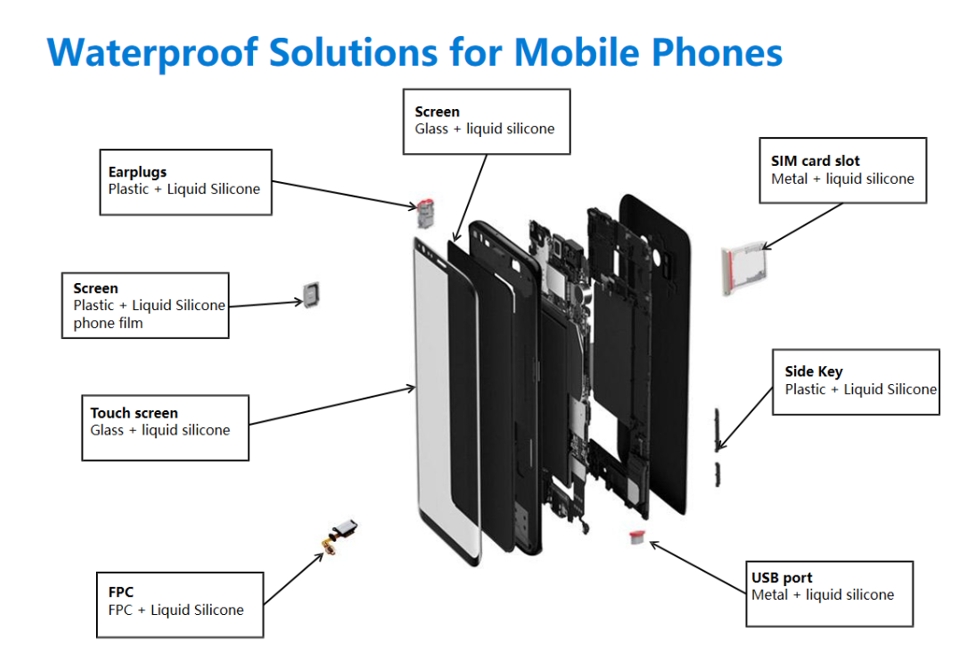
In recent years, as people's demand for health and medical care has continued to rise, the performance requirements for medical devices have also become increasingly stringent. As a high-quality silicone material, liquid silicone rubber (LSR) is finding widespread application in the medical field thanks to its outstanding performance.
We can see that LSR silicone is widely used in various medical devices, such as catheters, seals, and gaskets. Among them, catheters, as one of the fastest-developing and most widely-applied medical devices, the advantages of LSR material are particularly prominent. Studies have shown [1] that LSR has excellent biocompatibility, chemical stability, and mechanical properties, which can meet the strict material requirements of medical devices.
Compared to traditional materials, LSR not only can achieve miniaturization and thin-wall design, but also provide multi-cavity and one-piece molding functions, greatly improving the performance and user experience of medical devices.
In addition, with the increasing demand for home healthcare equipment and disposable medical products, LSR silicone, as an ideal medical material, is also seeing growing market demand [2]. The industry predicts that the application of LSR in the medical field will continue to grow in the coming years, injecting new momentum into the medical device industry.
In summary, LSR silicone material, with its outstanding performance and broad application prospects, is becoming the preferred high-quality material for medical device manufacturers. We believe that with the continuous progress of technology, LSR will play an increasingly important role in the medical field and make greater contributions to human health.
[1] Smith, J., & Johnson, K. (2022). Biocompatibility of Silicone Materials in Wearable Devices. Journal of Materials Science, 57(12), 5678-5689.
[2] Lee, M., & Park, S. (2021). Silicone Elastomers for Wearable Device Applications. Advanced Materials, 33(18), 2101032.
![]()
According to the report from the International Data Corporation (IDC) [1], by 2023, earwear devices and smartwatches will account for more than 70% of the overall wearable device shipments. This trend highlights the importance and widespread application of wearable devices in our daily lives.
In terms of material selection for wearable devices, silicone is emerging as the leading choice. Research shows [2] that silicone has excellent biocompatibility, making it suitable for various skin-contact applications, including wearable skin-attached devices and medical-grade wearables. Its outstanding flexibility and conformability provide users with a comfortable wearing experience.
Among silicone materials, Liquid Silicone Rubber (LSR) and solid silicone rubber have gained significant attention in recent years due to their excellent mechanical properties, chemical resistance, and high-temperature tolerance. Compared to traditional Thermoplastic Elastomer (TPE) materials, LSR and solid silicone rubber have higher tear resistance, abrasion resistance, and weatherability, better meeting the demanding usage environments of wearable devices [3].
Furthermore, silicone can be widely applied in the design of smartwatch, smart bracelet, and other wearable device straps and housings [4], providing excellent waterproofing, sweat resistance, and wear resistance. This not only enhances the practicality of the devices but also further improves the user experience.
In conclusion, silicone, as an ideal material for wearable devices, is driving the entire industry towards a more intelligent, comfortable, and safe direction. With the continuous advancement of technology, we believe that future wearable devices will be integrated into our daily lives in an even more body-centric manner.
[1] IDC. (2023). Wearable Device Forecast Report.
[2] Smith, J., & Johnson, K. (2022). Biocompatibility of Silicone Materials in Wearable Devices. Journal of Materials Science, 57(12), 5678-5689.
[3] Lee, M., & Park, S. (2021). Silicone Elastomers for Wearable Device Applications. Advanced Materials, 33(18), 2101032.
[4] Kim, H., & Lee, J. (2020). Comparison of Silicone, TPE, and Other Elastomers for Wearable Device Applications. Polymers, 12(6), 1311.
![]()
Silicone rubber is a thermoset material characterized by a backbone of alternating silicone and oxygen atoms, often with methyl or vinyl side groups. Known for its exceptional performance in extreme environments, it has earned its reputation as a leading elastomer. Additionally, silicone rubber is one of the most permeable elastomers available.
There are two primary types of silicone rubber: solid and liquid. While their fundamental structures are similar, their curing and processing methods differ significantly. This article provides a comprehensive overview of liquid silicone rubber (LSR) and high-consistency rubber (HCR), detailing their similarities, differences, applications, and guidance on selecting the most suitable material for your specific needs.
LSR is particularly well-suited for products that demand high precision and quality. Key applications include:
Seals and Gaskets: Providing excellent sealing capabilities in various environments.
Diaphragms and Membranes: Ideal for applications requiring flexibility and durability.
Cushioning Pads: Used in portable communication devices to enhance comfort.
Data Acquisition Instruments: Ensuring reliability in sensitive equipment.
Rugged Electronic Devices: Protecting components in harsh conditions.
Infant Products: Such as bottle nipples and pacifiers, ensuring safety and hygiene.
Electrical Connectors: Offering insulation and protection against moisture.
Wearables: Used in health monitoring devices and drug delivery systems.
Medical Applications: Including septums, actuators, and dosing valves.
Moreover, LSR is increasingly utilized for over-molding onto other plastic components, enhancing product performance and aesthetics.
HCR undergoes catalyzation processes that allow for a wide range of silicone rubber products. Common applications include:
Medical Devices: Such as implantable shunts, pacemaker lead coverings, and catheters.
Compression Molding: Often used for components requiring robust durability.
Extruded Tubing: Suitable for various industrial applications.
LSR vs. HCR
The primary distinction between LSR and HCR lies in their viscosity and processing methods. LSR has a lower viscosity, allowing for easier flow and processing via injection molding, making it ideal for high production volumes. The automated nature of LSR injection molding reduces labor costs and enhances efficiency.
Conversely, HCR's higher viscosity can complicate handling, necessitating more labor-intensive processing methods like transfer and compression molding. While HCR may involve higher labor costs and material waste, it offers advantages in applications where durability and toughness are paramount.
Cost Considerations
The costs associated with liquid injection molding can escalate quickly due to the investment in specialized tooling and equipment, particularly during the design and development phase. Although LSR injection molding involves fewer steps, the expertise required for effective implementation surpasses that of typical plastic manufacturing processes.
Choosing a manufacturing partner with the necessary capabilities and experience is crucial for project success. A reliable supplier can guide you through the design and material selection process, ensuring optimal outcomes.
What Is HCR?
High-consistency rubber, also known as heat-cured rubber or high-temperature vulcanizing rubber, consists of polymers with high molecular weight and long chains. HCR exhibits properties such as resiliency and excellent recovery after elongation or compression. Manufacturers produce HCR in large batches by mixing components at elevated temperatures using peroxide catalysts.
Characteristics of HCR
HCR is a solid, gum-like silicone elastomer known for its elastic mechanical vulcanization. It offers remarkable resistance to heat, cold, and extreme weather conditions, along with excellent electrical properties. Manufacturers can tailor HCR formulations by adding fillers and modifiers to meet specific requirements.
HCR Fabrication Process
The fabrication of HCR involves several steps:
Mill Softening and Catalyzation: This process reverses “crepe hardening” and incorporates peroxide catalysts.
Preparing a Preform: Cutting the elastomer into appropriate shapes for molding.
Extrusion: Shaping the material through an extruder to achieve desired profiles.
Molding: Utilizing various molding techniques, including transfer and compression molding.
Vulcanization: Cross-linking the molecules to enhance durability.
Finishing: Involves inspection and trimming to meet specifications.
Despite its advantages, HCR fabrication can lead to material waste and higher labor costs due to manual handling and additional equipment requirements.
What Is LSR?
Liquid silicone rubber (LSR) consists of low-viscosity liquid silicone processed through injection molding or cast into sheets. The uncured LSR material comprises two components: Component A, containing a platinum catalyst, and Component B, containing a cross-linker and an alcohol inhibitor. The curing process is initiated when these components are mixed and heated.
Characteristics of Liquid Silicone Rubber
LSR is distinguished by its impressive performance characteristics and rapid cure cycles, making it ideal for small, intricate molded components. It maintains elasticity and flexibility at temperatures as low as -60°C and retains these properties up to 250°C.
LSR Processing
LSR processing involves two primary steps:
Meter Mixing: Delivering the two-part mixture in a precise 1:1 ratio to minimize waste and ensure quality.
Molding: Utilizing automated machines specifically designed for LSR molding, resulting in minimal labor requirements.
LSR processing typically does not require extensive finishing, as well-designed molds minimize flash and eliminate the need for trimming.
Silicone Cure Mechanisms
Silicone rubber products utilize two primary curing mechanisms: free radical and addition cure.
Free Radical Cure
This mechanism involves the addition of heat to initiate peroxide catalysts, leading to cross-linking through free radical reactions along the polymer backbone.
Addition Cure
Commonly used for both LSR and HCR, this method involves adding silicon hydride to unsaturated carbon bonds in the presence of a noble metal catalyst, typically platinum. Notably, addition curing generates no byproducts, reducing the need for post-curing processes.
Considerations for Material Selection
When selecting between HCR and LSR, decision-makers should evaluate several critical factors:
Hardness: Measured on the Shore A Hardness Scale, ranging from very soft to very hard.
Tear Resistance: Indicates how well the material can withstand tearing forces.
Compression Set Resistance: Reflects the material's ability to recover from deformation.
Elongation: Important for products requiring significant stretching or sealing capabilities.
Biocompatibility: Essential for medical applications, where materials must be non-toxic and stable.
Conclusion: Choose Silicone Rubber for Your Commercial and Manufacturing Projects
Silicone rubber has been a staple in various industries, including medical, automotive, industrial, and consumer electronics. Advances in material technologies and manufacturing processes have expanded its applications in life-enhancing and critical-care contexts.
The choice between high-consistency rubber and liquid silicone rubber depends on product requirements and application specifications. For further inquiries or to learn more about the LSR injection molding process, consider reaching out to an expert with multidisciplinary experience who can help you find the ideal solution for your project.
PACKSONMOLD is a trusted silicone rubber manufacturer, having produced billions of LSR parts since our establishment in 2002. We serve leading manufacturers across nearly every industry, and we are committed to providing value-added custom solutions that enhance product quality, streamline processes, and meet your program objectives.
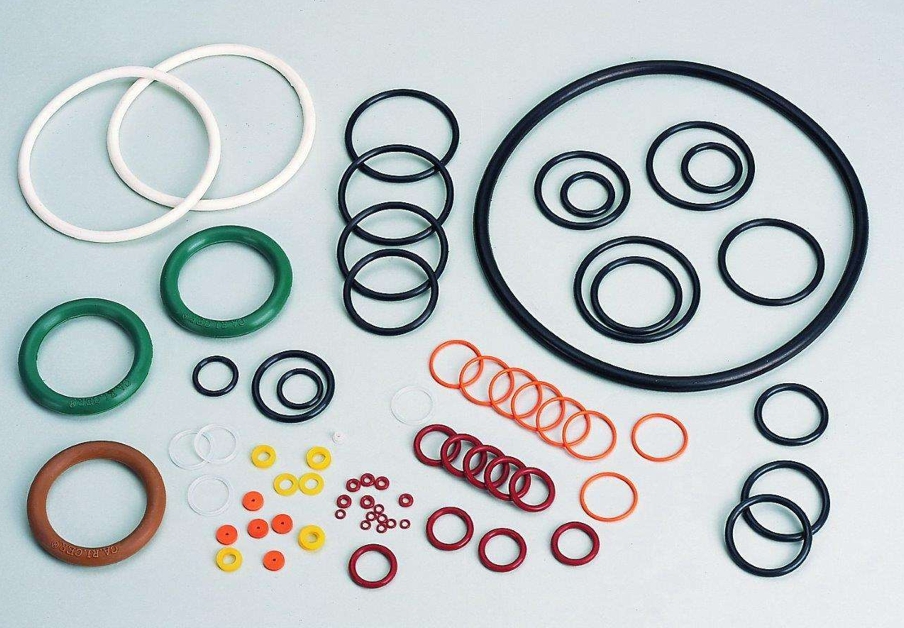
Leakage has always been a major pain point plaguing the e-cigarette industry. By adopting a one-piece injection molding process of silicone and plastic, e-cigarette products can significantly improve sealing performance and completely solve the problem of oil and liquid leakage.
The main reasons for choosing LSR as the sealing material for e-cigarettes are:
1. High elasticity and toughness: LSR material has excellent elasticity and toughness, which can effectively resist external force compression and maintain good sealing performance.
2. Environmentally friendly and odorless: LSR is an environmentally friendly and non-toxic material, which will not pose any health risks to users, and also has no odor issues.
3. Dimensional stability: The use of high-precision CNC machining technology to manufacture components can ensure the dimensional stability of the sealing parts, ensuring long-term sealing effectiveness.
4. High-temperature resistance: LSR material can maintain good physical properties even in high-temperature environments, ensuring that the e-cigarette can maintain sealing performance in high-temperature use scenarios.
In summary, the excellent performance characteristics of LSR material provide a brand-new sealing solution for the e-cigarette industry. This innovative material and process undoubtedly inject new momentum into the further development of the e-cigarette industry and help improve the user experience.
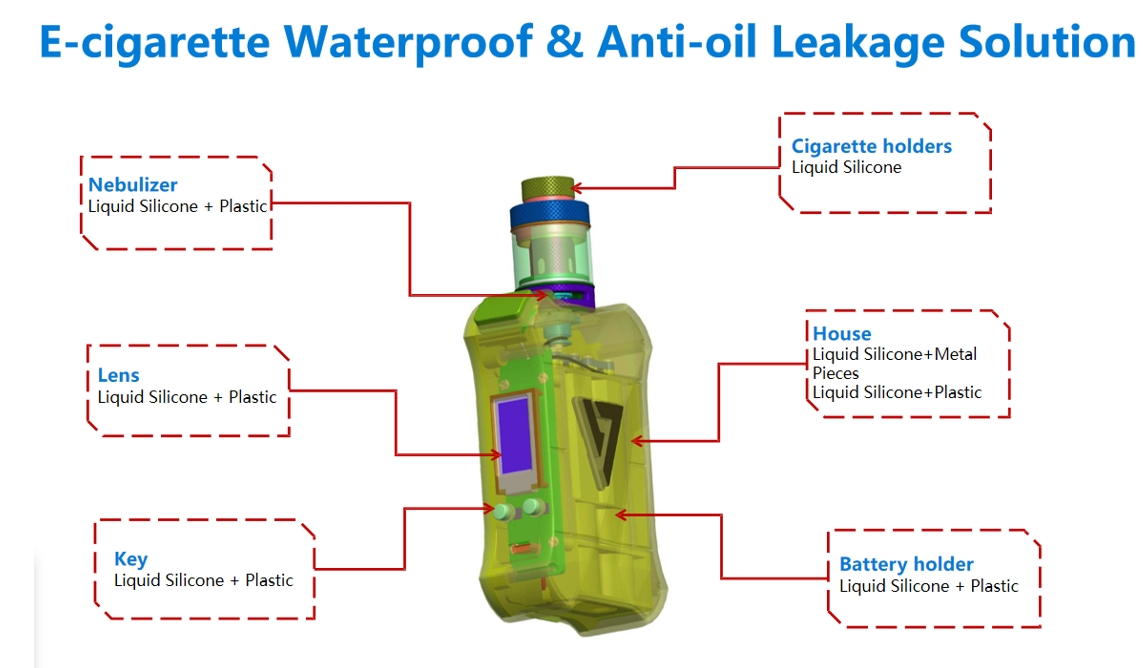
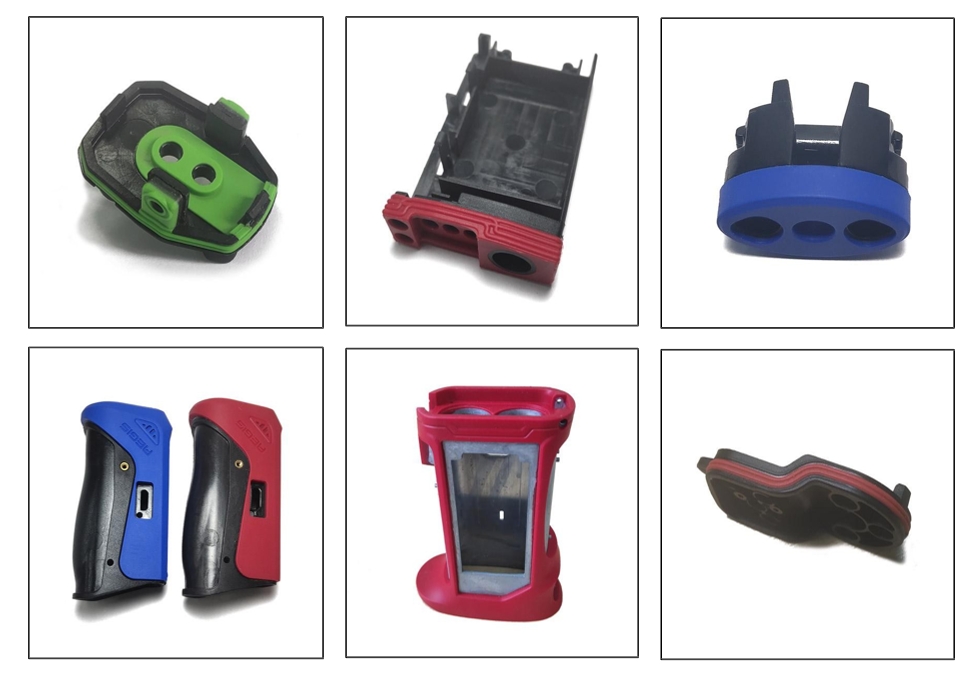
In today's market, the demand for high-quality durable consumer products continues to grow, and food-grade silicone has emerged as the material of choice for many household items. Food-grade silicone not only offers strength and durability but also excels in safety and environmental friendliness, making it widely used in baby products, kitchen utensils, and food storage containers.
Liquid Silicone Rubber (LSR) is an odorless, tasteless material with excellent antibacterial properties. Its unique hydrophobic nature and ease of cleaning make it an ideal choice for food-related products. LSR's temperature resistance allows it to maintain stability in both high and low-temperature environments, suitable for various kitchen appliances and home devices.
PACKSONMOLD's Expertise
PACKSONMOLD has extensive experience in the production of food-grade liquid silicone rubber, providing comprehensive services from design to manufacturing. Our team is dedicated to helping clients overcome challenges in product development, including design, material selection, and production processes.
Diversity in Injection Molding
PACKSONMOLD utilizes advanced injection molding technology to meet clients' demands for high precision and consistency. Our injection molding process is adaptable for both large-scale production and small-batch customization. Additionally, our two-shot and multi-shot injection molding techniques allow for the combination of different materials, enhancing product functionality and aesthetics.
Key Application Areas
Food-grade LSR is applicable in a variety of products, including but not limited to:
Baby Products: Such as baby bottles and pacifiers, ensuring safety and durability.
Kitchen Utensils: Including oven mitts and baking molds, capable of withstanding extreme temperatures.
Industrial Applications: Including seals and valves for food processing equipment, ensuring hygiene and performance.
Compared to traditional materials, food-grade LSR offers several unique advantages:
Environmental Friendliness: LSR materials are recyclable, aligning with sustainable development goals and reducing environmental impact.
Chemical Resistance: Its excellent chemical inertness allows it to remain stable when in contact with various foods and cleaning agents, preventing degradation.
Design Flexibility: The low viscosity of LSR enables it to fill complex molds, accommodating diverse design needs, including the manufacture of micro-components.
PACKSONMOLD is committed to delivering high-quality products and has achieved ISO 9001, ISO 13485, and IATF 16949 certifications. These certifications not only ensure that our production processes meet international standards but also provide clients with additional confidence in the consistency and reliability of our products.
During the initial phase of a new project, PACKSONMOLD works closely with clients to thoroughly understand their needs. We focus on several aspects:
Usage Scenarios: The performance and functionality of the product in actual use.
Environmental Adaptability: The conditions under which the product will be used.
Aesthetics and Functionality: Enhancing the visual appeal of the product while meeting functional requirements.
Regulatory Compliance: Ensuring that the product meets industry standards and regulatory requirements.
By choosing PACKSONMOLD, you will benefit from:
Customized Services: Tailored solutions based on specific client needs.
Innovative Technology: Utilizing advanced production techniques to ensure product quality and efficiency.
Comprehensive Support: Professional teams supporting every stage from design to production.
With PACKSONMOLD's extensive experience and expertise in food-grade liquid silicone rubber, we are well-equipped to provide innovative solutions that help your products succeed in the market.
![]()
The rapid development of the automotive industry has led to a continuous increase in the demand for precision components. The LSR (Liquid Silicone Rubber) molding technology, with its unique advantages, plays a key role in meeting this demand (Zhao et al., 2020).
LSR molds can quickly manufacture complex, high-precision automotive electronic relays, connectors, wiring harness components, and other critical components. Compared to traditional injection molding, LSR molds have a shorter cycle time and lower cost, making them very suitable for meeting the automotive industry's demand for rapid model changes (Zhang & Li, 2018).
At the same time, LSR components have excellent heat resistance, chemical resistance, and reliability, making them highly suitable for application in the harsh environments of automotive electrical systems (Gao et al., 2021). The lightweight and durable characteristics of LSR components also contribute to vehicle lightweighting, improving fuel efficiency (Wang & Liu, 2019).
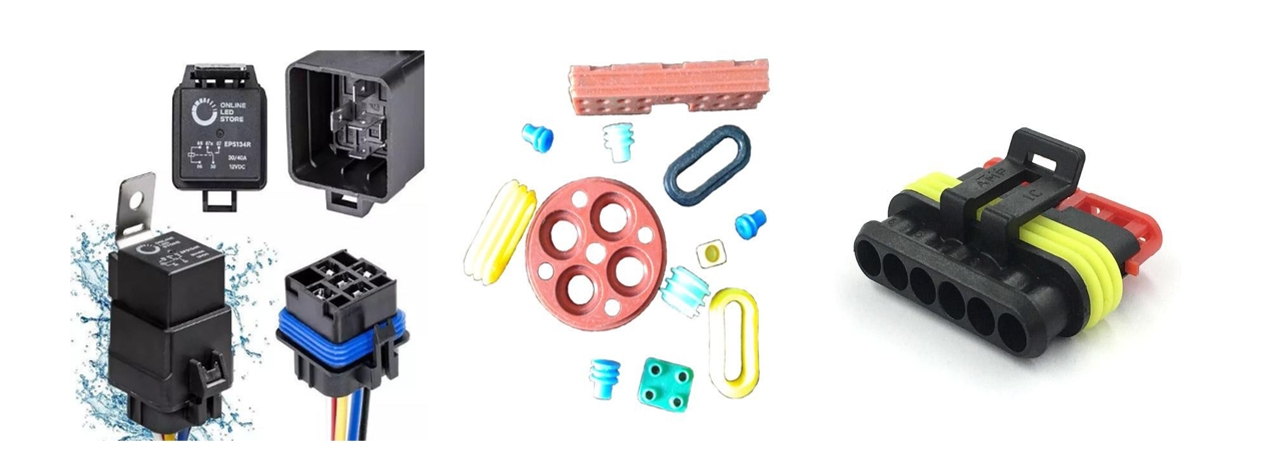
Liquid silicone rubber is widely used in the automotive industry, making it the material of choice for manufacturing a variety of components, including seals, gaskets, diaphragms, and hoses. The unique properties of LSR make it stand out in several areas:
Relays:
A critical component widely used in automotive electronic systems.
LSR molds can quickly manufacture high-precision, complex-structured relay housings and internal components.
The short manufacturing cycle and low cost of LSR molds are beneficial for meeting the automotive industry's demand for rapid model changes (Li & Zhang, 2020).
Connectors:
An indispensable component in automotive wiring harness systems.
LSR molds can manufacture connectors with beautiful appearances and complex structures.
LSR connectors have good heat resistance and chemical resistance, suitable for use in harsh environments (Xu & Wang, 2021).
Wiring Harness Components:
One of the core components of the automotive electrical system.
LSR molds can integrally mold complex wiring harness mounting brackets and sheaths.
LSR components are lightweight and durable, contributing to vehicle lightweighting and improved fuel efficiency (Chen & Li, 2019).
LSR in Electric Vehicles
As the electric vehicle market continues to grow, the application of LSR is also diversifying. Experts project that the global LSR market will have a compound annual growth rate of 8.5% between 2022 and 2023. This growth can be attributed to industries like healthcare and automotive that are constantly finding new uses for the material.
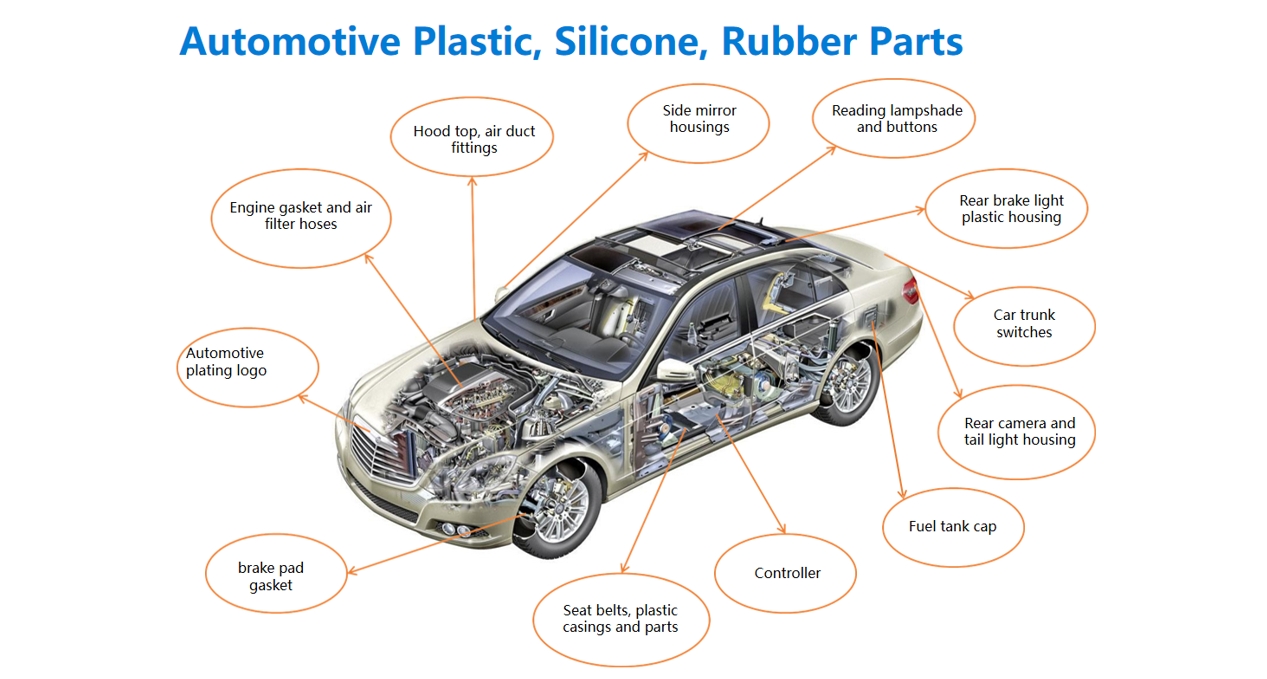
Insulation:
LSR plays a major role in thermal management for electric vehicles, providing a protective barrier for battery performance.
Battery Performance:
LSR components can encapsulate EV batteries to protect against moisture and chemical exposure.
Vibration Dampening:
LSR is effective as a vibration dampener, reducing the transmission of vibrations from engines and other components, ensuring smooth operation.
Sealing:
LSR's impressive sealing properties create water-tight barriers that keep moisture away from sensitive components, enhancing battery performance and safety.
Conclusion
As the automotive industry continues to advance, LSR molding technology will undoubtedly play an increasingly important role in the future. By leveraging the advantages of LSR, automotive manufacturers can produce lighter and more efficient components to meet the ever-changing market demands. PACKSONMOLD provides custom LSR solutions to meet the strict requirements of the automotive industry, supporting the future of automotive manufacturing.
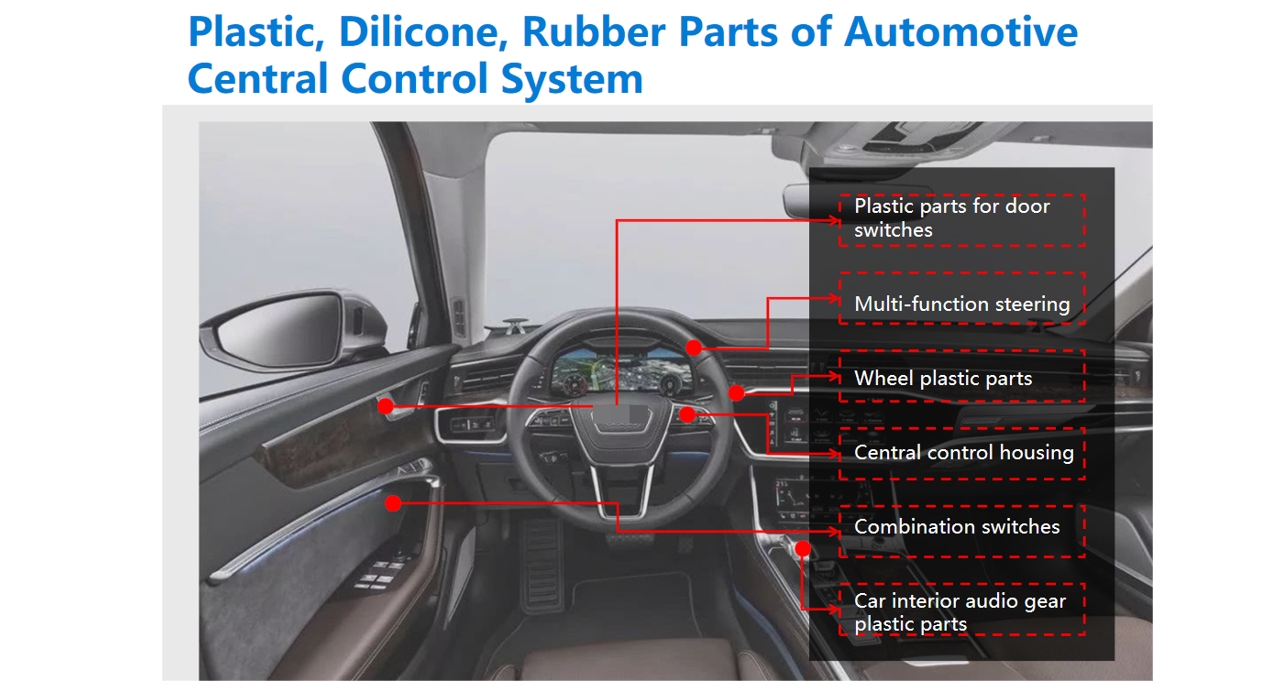

Class 8 Clean Room
Class 8 cleanroom injection molding is capable of providing you with high-quality, low-pollution plastic products.
Quality Control
Equiping with precision processing and production equipment, and strictly adhere to the quality control processes of ISO9001 and ISO13485 to ensure quality control.
Professional Engineering
Our professional Mold Design Team provides reasonable solutions that help reduce customer development and tool-making costs.
Precise Manufacture
Our world-class production and testing equipment provides a strong guarantee for the precision of your products.
Project Management
Our Bilingual Project Engineers with many experiences ensure smooth project operations and communication.